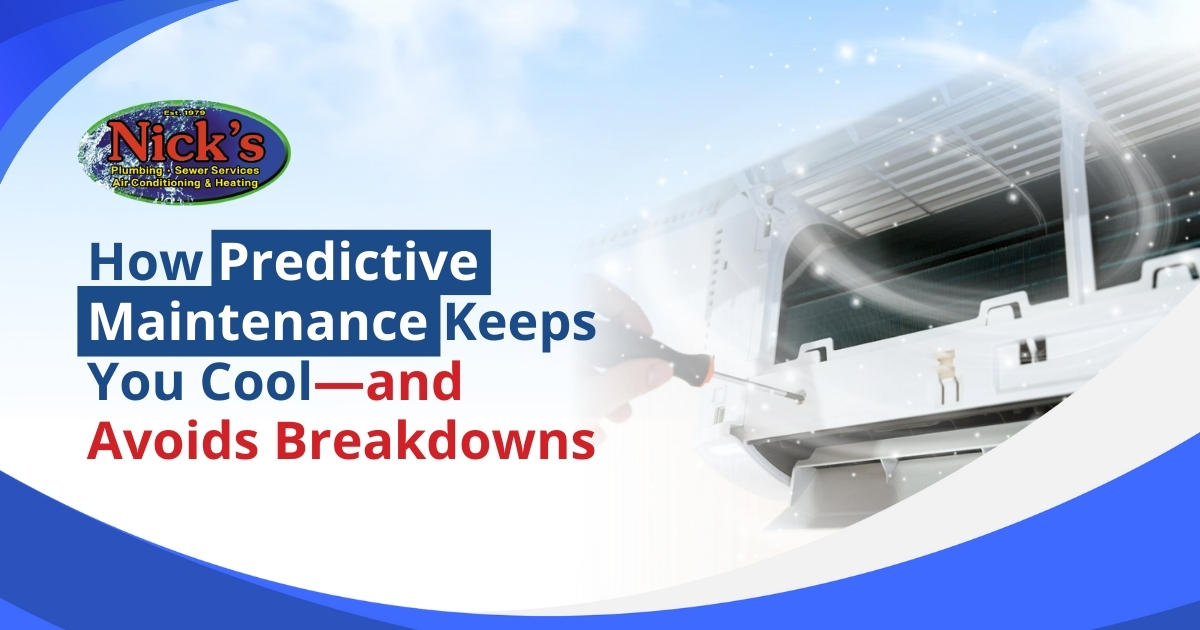Author: Onboarding
HVAC systems are moving into the future. Instead of the “set it and forget it” thermostats we’ve grown accustomed to, or adhering to the mantra of “maintenance service every year no matter what,” the next leap is toward systems that monitor themselves. With predictive air conditioner maintenance, your system can anticipate problems before they become emergencies — giving you cooler comfort, fewer breakdowns, and less stress about summer surprises.
Let’s take a stroll down the path of what smart HVAC really means, how predictive maintenance works, and whether the technology is truly ready now — or still a few steps away from being accessible for most homes.
First Things First: What Is a Smart HVAC System?
Think of a conventional HVAC system as an AM radio with just volume and tuning knobs. A “smart” HVAC system, by contrast, is like a streaming music service: it listens, adapts, self-tunes, and evolves. Smart HVAC uses sensors to monitor temperature, humidity, airflow, vibration, energy draw, and more. All this data feeds into algorithms that interpret what the system “should” be doing — and where it’s starting to drift.
In smart HVAC, things like AC performance monitoring and HVAC maintenance technology aren’t extras — they’re built in. The system takes in internal signals, as well as external context — such as weather forecasts, utility rates, and usage patterns — to create a kind of “treatment plan” for itself. The goal: your system runs better, longer, and more efficiently without you having to chase down problems.
The Three Strategies of Smart HVAC Maintenance: Reactive, Preventive, Predictive.
When it comes to keeping your system healthy, there are three broad strategies:
- Reactive Maintenance — Wait until something breaks and then fix it.
- Preventive Maintenance — Perform checkups at scheduled intervals (quarterly, yearly), whether or not there’s a problem.
- Predictive Maintenance — Use real-time data and AI to see wear, drift, or issues with internal components before they fail, allowing you to schedule professional intervention only when necessary.
How Predictive Maintenance Works to Keep You Cool All Summer and Cozy All Winter.
Predictive maintenance is what happens when your HVAC system makes the transition from being “just another appliance” that you have to program to something more akin to a self-driving car, with self-awareness. Inside the unit, small sensors constantly monitor what’s happening behind the scenes — tracking the temperature of the compressor, the vibration of the fan motor, the pressure in the refrigerant lines, and the system’s overall energy consumption.
All that information is sent to a secure digital platform, where it’s compared against what “normal” operation looks like for your specific system. Over time, the software starts learning your unit’s patterns — how it behaves on a mild spring day versus a blazing Houston summer afternoon. When something begins to stray from the expected, such as a compressor drawing more power than usual or a fan motor vibrating slightly too much, the system flags it before the problem becomes noticeable.
From there, it can send a quick alert or recommendation, suggesting that it’s time to clean the coil, tighten a connection, or schedule a quick inspection. Instead of reacting to a breakdown, you and your HVAC technician can address the issue while it’s still small, saving time, money, and comfort during your next 95-degree day.
Maximizing Comfort with Intelligent Controls.
Predictive maintenance isn’t only about preventing breakdowns — it’s about keeping your home feeling comfortable day after day. Smart HVAC systems constantly monitor and gather data on how your house operates, from that one room that never quite warms up to the way the humidity seems to rise in the upstairs bedrooms in the afternoon. Instead of waiting for you to notice, the system makes minor adjustments on its own to even things out and maintain a comfortable environment.
To utilize a truly autonomous HVAC system to its full potential, it means employing zoning control — treating each area of the home differently based on occupancy, sensor feedback, or load. If it senses that a guest room is usually unoccupied, it might reduce the AC in that room while maintaining the living room’s perfect comfort. Smart systems also monitor humidity, so you don’t end up freezing to control the moisture. And when energy demand across the grid spikes, the system can scale itself back for a short time, trimming your costs without sacrificing comfort.
Benefits of Smart HVAC and Predictive Maintenance for Homeowners.
Avoiding Costly Emergency Repairs:
Predictive systems enable you to catch minor issues — such as motor wear, a clogged filter, low refrigerant, or coil fouling — before they escalate into breakdowns. Fewer emergency service calls mean lower maintenance overhead.
Consistent Comfort in Texas Heat:
Systems tuned via real-time feedback maintain temperature and humidity more precisely, resisting drift caused by dust, wear, or seasonal variations.
Lower Energy Bills:
By ensuring the system always runs near optimal parameters, predictive technology reduces waste. Dirty coils, for example, force the compressor to work harder — a form of energetic inefficiency that a smart system can detect early. Studies suggest that predictive maintenance models can reduce maintenance costs by 25–40% over reactive models.
Extending AC Lifespan:
Parts that are pushed beyond tolerances degrade faster. By adjusting and correcting early, predictive maintenance extends component life and the system’s overall longevity. Sera+1
Can I Retrofit My Existing HVAC System to Be Smart?
Good question. The short answer is yes, often with limitations.
Most older HVAC systems – heck, even most of the current systems on the market were basically built “dumb” — meaning sensors weren’t included, or certain control boards weren’t capable of supporting advanced features. However, you can retrofit many systems with third-party sensor arrays, smart control modules, and analytics platforms. These act as an “overlay” that adds some of those intelligent features to your existing system without requiring a complete replacement.
However, deeper integration (predictive control loops, coil-cleaning scheduling, advanced diagnostics) may require newer control boards or modular upgrades. That’s why a consultation with one of Nick’s fully trained HVAC technicians is necessary, as they can evaluate whether your current equipment supports a retrofit or if a partial upgrade is required.
What Is the Process for Installing a Smart HVAC System?
Setting up a smart HVAC system isn’t as simple as swapping out a thermostat — it’s a thoughtful, step-by-step process that ensures every part of your system can communicate and respond the way it should.
It begins with a comprehensive system audit, where a technician assesses your existing components, wiring, and ductwork to determine what can be integrated and what may require updating. Once that’s mapped out, sensors are installed in key areas — places like around the compressor, within the ducting, and along primary airflow paths — to start collecting temperature, vibration, and performance data.
Next comes the control module installation. This is what allows the sensors to “talk” to the analytics platform that interprets the data. Once connected, that data platform is set up and trained to recognize your home’s baseline performance, creating a reference point for what “normal” looks like.
After installation, the system goes through a tuning period. It operates under real-world conditions, fine-tuning readings, adjusting thresholds, and learning how your home’s HVAC system behaves on a day-to-day basis. Over the next few weeks, it becomes sharper and more accurate, evolving into a system that doesn’t just run your home’s climate — it understands it.
It Doesn’t End With Predictive Maintenance: What’s Next for Smart HVAC?
Predictive maintenance might be the big headline right now, but it’s really just the beginning of what smart HVAC systems will be able to do. The next wave of technology will focus on making your home’s comfort systems more efficient, more connected, and even a little self-sufficient.
Autonomous Decision Making
Think of this as your HVAC system learning to make small judgment calls on its own. Future systems could automatically adjust how air moves through your home or fine-tune refrigerant flow to enhance comfort and energy efficiency, eliminating the need for human intervention. If a part begins to show wear, the system may temporarily adjust its operation to ease the strain until service is scheduled. It’s not science fiction; it’s simply smarter, data-driven control.
Digital Twin Modeling
A “digital twin” is a virtual copy of your HVAC system that runs in a computer environment. It mirrors your real system’s behavior and tests out “what if” scenarios before anyone touches a wrench. For homeowners, that means fewer surprises and faster, more accurate repairs or adjustments — the system itself can help predict how to solve problems before they affect comfort or performance.
Cross-System Integration
Your HVAC system won’t remain isolated for long. Future versions will talk directly with solar panels, battery storage systems, and even your local electric grid. That means your AC could automatically cool your home more when solar power is abundant and ease off when energy demand is high — saving money and reducing strain on the grid. Even your home’s lighting and shades could be synced up, all working together to balance comfort and efficiency.
Local AI (Edge Processing)
Currently, most smart devices transmit their data to the cloud for analysis. In the near future, HVAC systems will process much of that data right inside your home — no internet required. This “local intelligence” means faster responses, more privacy, and continued operation even if your Wi-Fi goes down. It’s like giving your air conditioner its own onboard brain, capable of making autonomous decisions instantly instead of waiting for outside input.
Some Quick FAQ’s About Predictive Maintenance:
Can Predictive Maintenance Save Me Money on AC Repairs?
Yes. Because the system spots issues early, you’re only repairing small parts instead of dealing with catastrophic breakdowns.
Can Predictive Maintenance Extend My HVAC System’s Lifespan?
Yes. By keeping components operating within safe tolerances and reducing strain, you slow down wear and extend usable life.
Does Smart HVAC Compatibility Require a Complete System Replacement?
Not always. Many systems can be retrofitted. It depends on your control board, wiring, and ability to host sensors.
Smarter Tech, Same Trusted Team: What is Nick’s Approach to Next-Gen HVAC?
The pace of this, and many other HVAC-related technologies, is accelerating at such a rapid rate that it’s already started reshaping what comfort means at home. Instead of reacting to heat, humidity, or mechanical issues after they occur, this next generation of HVAC systems will anticipate them — adjusting, balancing, and learning your family’s routine in real-time.
At Nick’s Air Conditioning, we keep a close eye on these innovations because we know they’re not just “tech trends” — they’re going to be the future in terms of how Houstonians stay cool. Whether it’s predictive maintenance, more intelligent sensors, or complete system integration, our goal is to help homeowners understand what’s coming and decide when it makes sense to take the next step.
Smart HVAC isn’t about replacing people; it’s about giving you more control, greater efficiency, and peace of mind. And when you’re ready to explore how these systems can fit your home, Nick’s is here to walk you through every option — one smart upgrade at a time.


